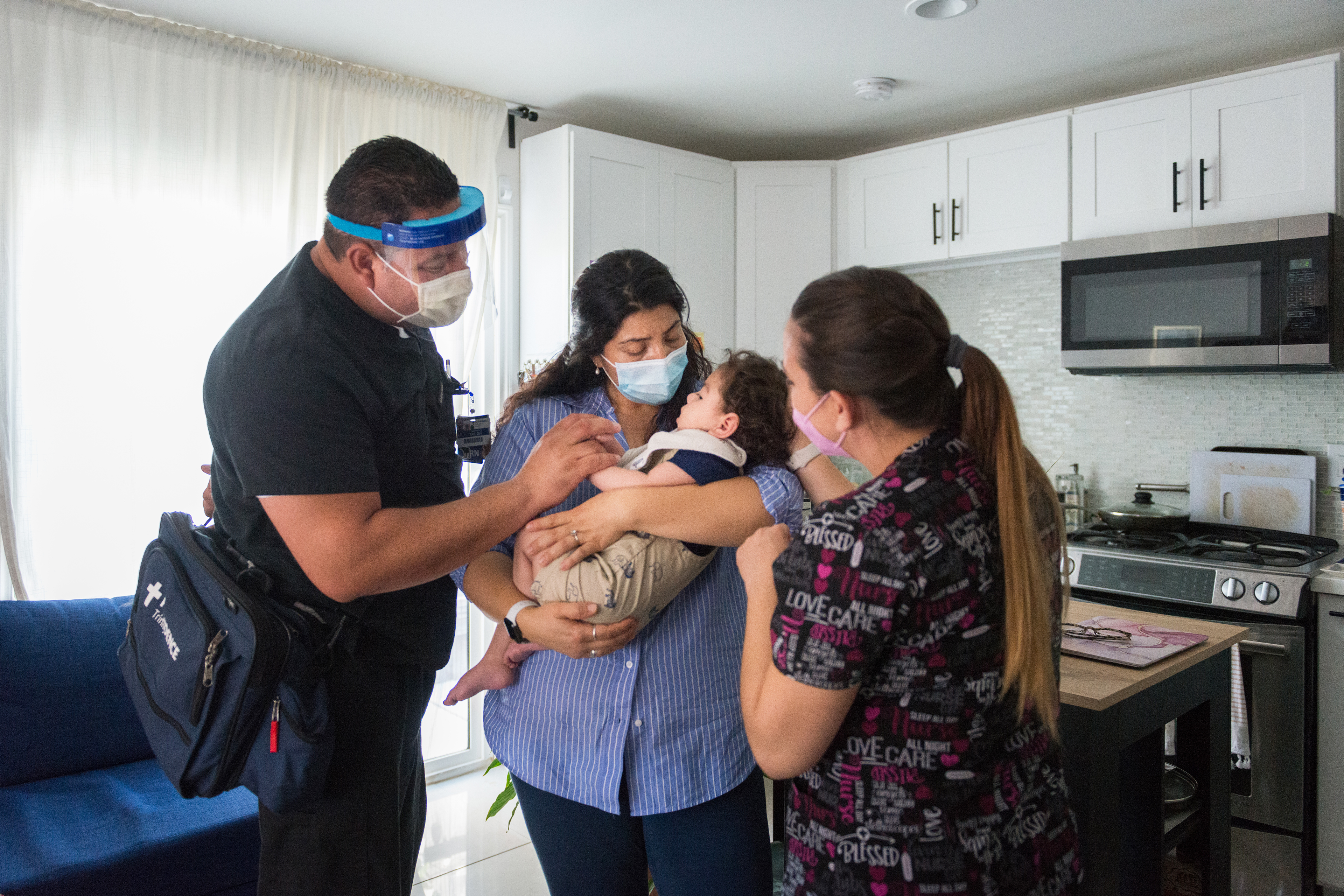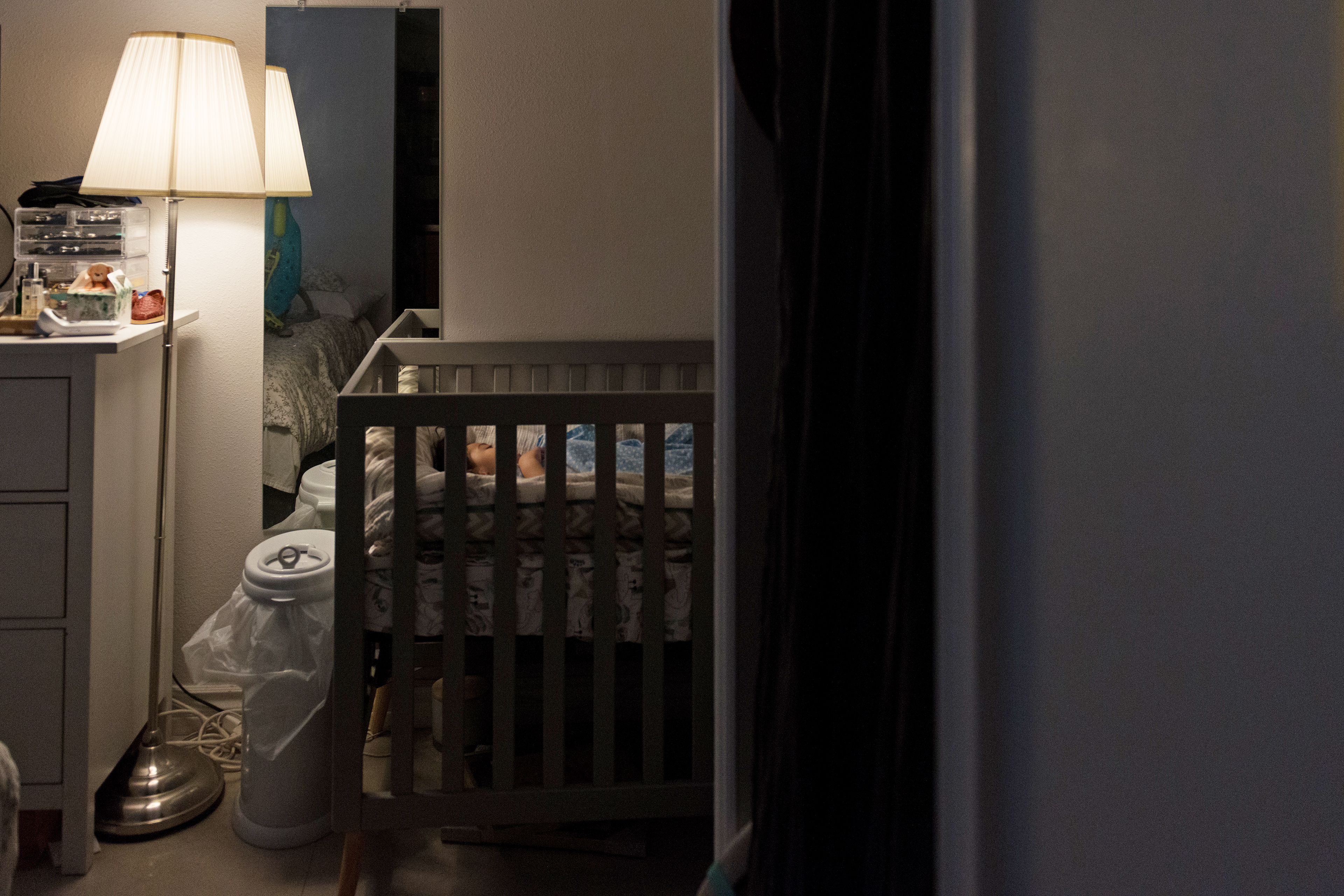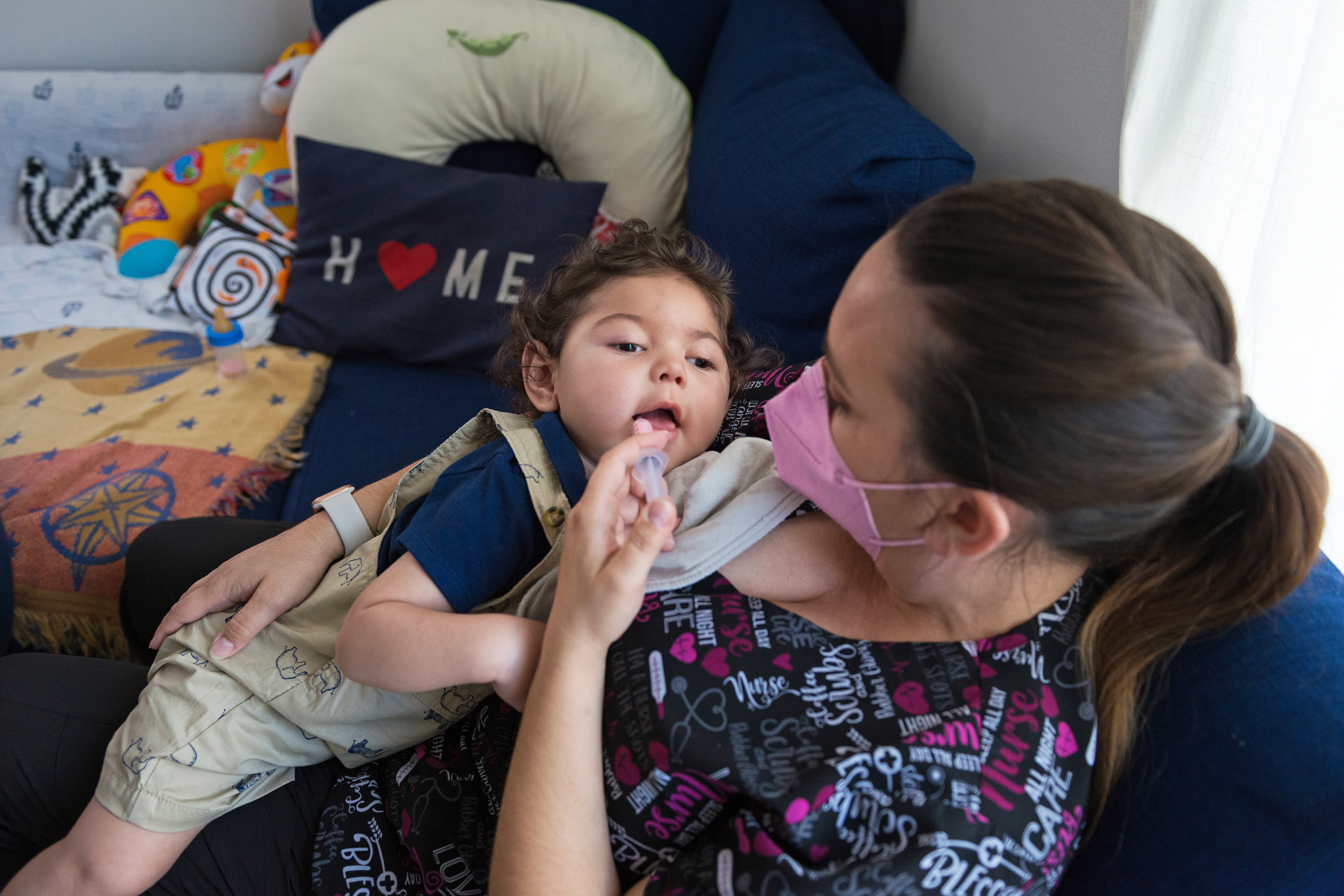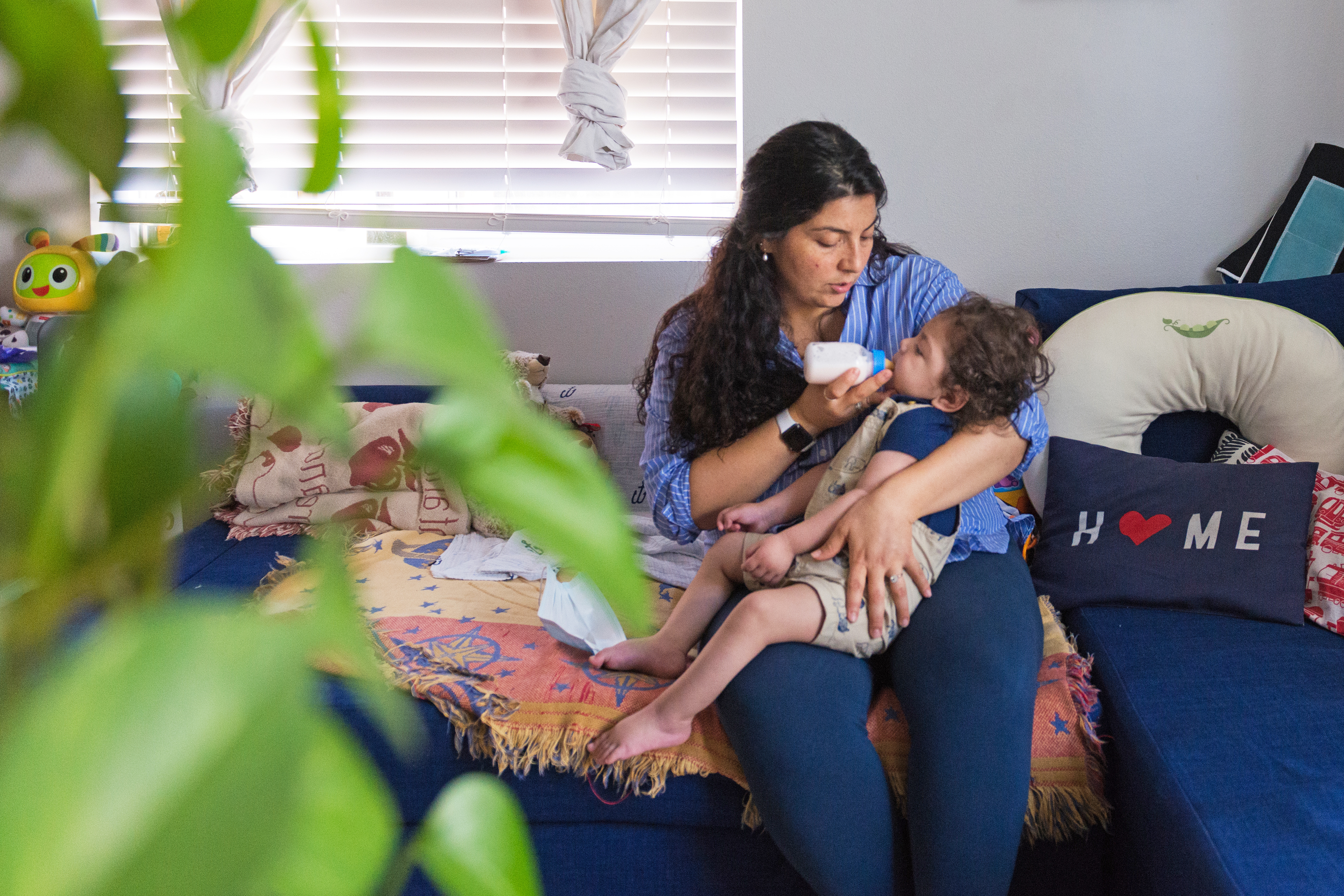POMONA, Calif. — If you first meet 17-month-old Aaron Martinez, it’s not apparent that one thing is catastrophically flawed.
What you see is a phenomenal little boy with easy, lustrous pores and skin, an abundance of shiny brown hair, and a disarming smile. What you hear are coos and cries that don’t instantly sign something is horribly awry.
However his mother and father, Adriana Pinedo and Hector Martinez, know the reality painfully effectively.
Though Adriana’s medical doctors and midwife had described the being pregnant as “good” for all 9 months, Aaron was born with most of his mind cells lifeless, the results of two strokes and an enormous bleed he sustained whereas in utero.
Docs aren’t certain what induced the anomalies that left Aaron with just about no cognitive perform or bodily mobility. His voluminous hair hides a head whose circumference is simply too small for his age. He has epilepsy that triggers a number of seizures every day, and his smile shouldn’t be all the time what it appears. “It could possibly be a smile; it could possibly be a seizure,” his mom stated.
Shortly after Aaron was born, medical doctors informed Adriana, 34, and Hector, 35, there was no hope and they need to “let nature take its course.” They might be taught months later that the medical doctors had not anticipated the boy to dwell greater than 5 days. It was on Day 5 that his mother and father put him in house hospice care, an association that has continued into his second yr of life.
The household will get weekly visits from hospice nurses, therapists, social staff, and a chaplain within the cramped one-bedroom residence they hire from the individuals who dwell in the principle home on the identical lot on a quiet residential road on this Inland Empire metropolis.

One of many most important standards for hospice care, established by Medicare largely for seniors but additionally utilized to youngsters, is a analysis of six months or much less to dwell. But over the course of 17 months, Aaron’s medical staff has repeatedly recertified his hospice eligibility.
Underneath a provision of the 2010 Reasonably priced Care Act, youngsters enrolled in Medicaid or the Youngsters’s Well being Insurance coverage Program are allowed, not like adults, to be in hospice whereas persevering with to obtain healing or life-extending care. Industrial insurers usually are not required to cowl this “concurrent care,” however many now do.
Greater than a decade since its inception, concurrent care is broadly credited with bettering the standard of life for a lot of terminally in poor health youngsters, easing stress on the household and, in some circumstances, sustaining hope for a remedy. However the association can contribute to a painful dilemma for folks like Adriana and Hector, who’re torn between their fierce dedication to their son and the futility of understanding that his situation leaves him with no future price hoping for.
“We might lose a life, but when he continues to dwell this manner, we’ll lose three,” stated Adriana. “There’s no high quality of life for him or for us.”
Aaron’s medical doctors now say he might conceivably dwell for years. His physique hasn’t stopped rising since he was born. He’s within the 96th percentile for peak for his age, and his weight is about common.
His mother and father have talked about “graduating” him from hospice. However he’s by no means secure for lengthy, and so they welcome the visits from their hospice staff. The seizures, generally 30 a day, are a persistent assault on his mind and, as he grows, the medicines meant to manage them have to be modified or the doses recalibrated. He’s at continuous danger of gastrointestinal issues and probably lethal fluid buildup in his lungs.
Adriana, who works from house for a nonprofit public well being group, spends a lot of her time with Aaron, whereas Hector works as a landscaper. She has chosen to dwell within the second, she stated, as a result of in any other case her thoughts wanders to a future during which both “he might die — or he received’t, and I’ll find yourself altering the diapers of a 40-year-old man.” Both of these, she stated, “are going to suck.”
Whereas most cancers is without doubt one of the main sicknesses afflicting youngsters in hospice, many others, like Aaron, have uncommon congenital defects, extreme neurological impairments, or unusual metabolic deficiencies.
“We now have illnesses that households inform us are one among 10 circumstances on the planet,” stated Dr. Glen Komatsu, medical director of Torrance-based TrinityKids Care, which supplies house hospice providers to Aaron and greater than 70 different youngsters in Los Angeles and Orange counties.

Within the years main as much as the ACA’s implementation, pediatric well being advocates lobbied onerous for the concurrent care provision. With out the potential of life-extending care or hope for a remedy, many mother and father refused to place their terminally in poor health youngsters in hospice, pondering it was tantamount to giving up on them. That meant the entire household missed out on the help hospice can present, not simply ache aid and luxury for the dying youngster, however emotional and religious care for folks and siblings beneath excessive duress.
TrinityKids Care, run by the massive nationwide Catholic well being system Windfall, doesn’t simply ship nurses, social staff, and chaplains into properties. For sufferers capable of take part, and their siblings, it additionally provides artwork and science tasks, train lessons, motion pictures, and music. Through the pandemic, these actions have been performed through Zoom, and volunteers ship wanted provides to the youngsters’s properties.
The power to get remedies that extend their lives is a serious purpose youngsters in concurrent care are extra seemingly than adults to survive the six-months-to-live analysis required for hospice.
“Concurrent care, by its very intention, very clearly goes to increase their lives, and by extending their lives they’re now not going to be hospice-eligible when you use the six-month life expectancy standards,” stated Dr. David Steinhorn, a pediatric intensive care doctor in Virginia, who has helped develop quite a few youngsters’s hospice applications throughout the U.S.
One other issue is that youngsters, even sick ones, are merely extra strong than many older individuals.
“Sick youngsters are sometimes in any other case wholesome, aside from one organ,” stated Dr. Debra Lotstein, chief of the division of consolation and palliative care at Youngsters’s Hospital Los Angeles. “They could have most cancers of their physique, however their hearts are good and their lungs are good, in comparison with a 90-year-old who at baseline is simply not as resilient.”
All of Aaron Martinez’s very important organs, aside from his mind, appear to be working. “There have been occasions once we’ve introduced him in, and the nurse seems to be on the chart and appears at him, and she will be able to’t imagine it’s that youngster,” stated his father, Hector.

When youngsters dwell previous the six-month life expectancy, they have to be recertified to remain in hospice. In lots of circumstances, Steinhorn stated, he’s prepared to recertify his pediatric sufferers indefinitely.
Even with medical doctors advocating for them, it’s not all the time straightforward for youngsters to get into hospice care. Most hospices care primarily for adults and are reluctant to take youngsters.
“The hospice will say, ‘We don’t have the capability to deal with youngsters. Our nurses aren’t skilled. It’s completely different. We simply can’t do it,’” stated Lori Butterworth, co-founder of the Youngsters’s Hospice and Palliative Care Coalition of California in Watsonville. “The opposite purpose shouldn’t be eager to, as a result of it’s existentially devastating and unhappy and onerous.”
Funds additionally play a task. Residence hospice care is paid at a per diem fee set by Medicare — barely over $200 a day for the primary two months, about $161 a day after that — and it’s usually the identical for teenagers and adults. Youngsters, notably these with uncommon circumstances, typically require extra intensive and modern care, so the per diem doesn’t stretch as far.
The concurrent care provision has made taking pediatric sufferers extra viable for hospice organizations, Steinhorn and others stated. Underneath the ACA, most of the bills for sure medicines and medical providers might be shifted to the affected person’s major insurance coverage, leaving hospices liable for ache aid and luxury care.
Even so, the comparatively small variety of youngsters who die every year from protracted illnesses hardly makes pediatric hospice an interesting line of enterprise in an trade craving development, particularly one during which non-public fairness traders are energetic and searching for an enormous payday.
In California, solely 21 of 1,336 hospices reported having a specialised pediatric hospice program, and 59 stated they served at the least one affected person beneath age 21, in keeping with an evaluation of 2020 state information by Cordt Kassner, CEO of Hospice Analytics in Colorado Springs, Colorado.
Hospice suppliers that do cater to youngsters typically face a extra fundamental problem: Even with the potential of concurrent care, many mother and father nonetheless equate hospice with acceptance of demise. That was the case initially for Matt and Reese Sonnen, Los Angeles residents whose daughter, Layla, was born with a seizure dysfunction that had no title: Her mind had merely did not develop within the womb, and an MRI confirmed “fluid taking on area the place the mind wasn’t,” her mom stated.
When Layla’s staff first talked about hospice, “I used to be within the automobile on my cellphone, and I virtually crashed the automobile,” Reese recalled. “The primary thought that got here to thoughts was, ‘It’s simply the top,’ however we felt she was nowhere close to it, as a result of she was sturdy, she was mighty. She was my little lady. She was going to get via this.”
About three months later, as Layla’s nervous system deteriorated, inflicting her to writhe in ache, her mother and father agreed to enroll her in hospice with TrinityKids Care. She died weeks later, not lengthy after her 2nd birthday. She was in her mom’s arms, with Matt shut by.
“Swiftly, Layla breathed out an enormous rush of air. The nurse checked out me and stated, ‘That was her final breath.’ I used to be actually inhaling her final breath,” Reese recounted. “I by no means wished to breathe once more, as a result of now I felt I had her in my lungs. Don’t make me chuckle, don’t make me exhale.”
Layla’s mother and father haven’t any regrets about their resolution to place her in hospice. “It was absolutely the proper resolution, and in hindsight we should always have carried out it sooner,” Matt stated. “She was struggling, and we had blinders on.”

Adriana Pinedo stated she is “infinitely grateful” for hospice, regardless of the heartache of Aaron’s situation. Generally the social employee will cease by, she stated, simply to say good day and drop off a latte, a small gesture that may really feel very uplifting. “They’ve been our lifeline,” she stated.
Adriana talks a few good friend of hers with a wholesome child, additionally named Aaron, who’s pregnant along with her second youngster. “All of the stuff that was on our checklist, they’re dwelling. And I like them dearly,” Adriana stated. “Nevertheless it’s virtually onerous to look, as a result of it’s like trying on the stuff that you just didn’t get. It’s like Christmas Day, staring via the window on the neighbor’s home, and also you’re sitting there within the chilly.”
But she appears palpably torn between that bleak regret and the unconditional love mother and father really feel towards their youngsters. At one level, Adriana interrupted herself midsentence and turned to her son, who was in Hector’s arms: “Sure, Papi, you’re so stinking cute, and you’re nonetheless my dream come true.”
This story was produced by KHN, which publishes California Healthline, an editorially impartial service of the California Well being Care Basis.










![Understanding AICPA Life Insurance Trust Refunds [Know Your Risks!]](https://insuremonkey.com/wp-content/uploads/2022/12/Understanding-AICPA-Life-Insurance-Trust-Refunds-120x86.png)





